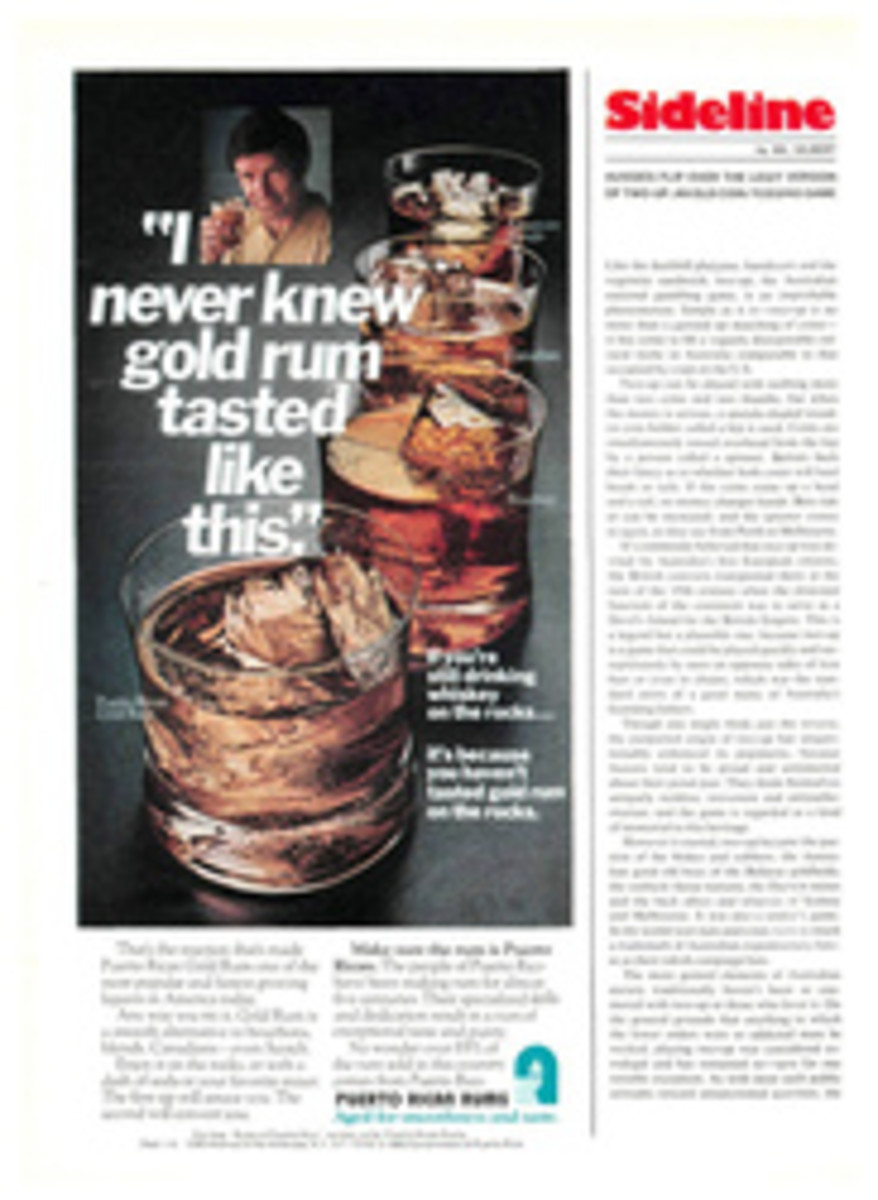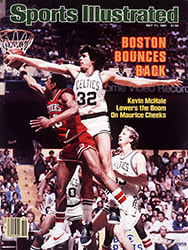
AUSSIES FLIP OVER THE LEGIT VERSION OF TWO-UP, AN OLD COIN-TOSSING GAME
Like the duckbill platypus, bandicoot and the vegemite sandwich, two-up, the Australian national gambling game, is an improbable phenomenon. Simple as it is—two-up is no more than a gussied up matching of coins—it has come to fill a vaguely disreputable cultural niche in Australia comparable to that occupied by craps in the U.S.
Two-up can be played with nothing more than two coins and two thumbs, but when the money is serious, a spatula-shaped wooden coin holder called a kip is used. Coins are simultaneously tossed overhead from the kip by a person called a spinner. Bettors back their fancy as to whether both coins will land heads or tails. If the coins come up a head and a tail, no money changes hands. Bets ride or can be increased, and the spinner comes in again, as they say from Perth to Melbourne.
It's commonly believed that two-up was devised by Australia's first European citizens, the British convicts transported there at the turn of the 19th century when the principal function of the continent was to serve as a Devil's Island for the British Empire. This is a legend but a plausible one, because two-up is a game that could be played quickly and surreptitiously by men on opposite sides of iron bars or even in chains, which was the standard attire of a good many of Australia's founding fathers.
Though one might think just the reverse, the purported origin of two-up has unquestionably enhanced its popularity, because Aussies tend to be proud and sentimental about their penal past. They think themselves uniquely reckless, irreverent and antiauthoritarian, and the game is regarded as a kind of memorial to this heritage.
However it started, two-up became the passion of the blokes and cobbers, the Australian good old boys of the Ballarat goldfields, the outback sheep stations, the Darwin mines and the back alleys and wharves of Sydney and Melbourne. It was also a soldier's game. In the world wars kips and coins were as much a trademark of Australian expeditionary forces as their rakish campaign hats.
The more genteel elements of Australian society traditionally haven't been so enamored with two-up or those who favor it. On the general grounds that anything to which the lower orders were so addicted must be wicked, playing two-up was considered extralegal and has remained so—save for one notable exception. As with most such public attitudes toward unsanctioned activities, the strictures on two-up have served principally to enhance employment opportunities for antivice agents and to create a new entrepreneurial class. These nimble cobbers have made a business of setting up floating games in warehouses, bunkrooms, large garages, sheep-shearing sheds and the like.
Given the history of the game, an announcement in the early 1970s that Australia's first gambling casino was to be opened in Hobart, Tasmania and that two-up would be played openly and legally there, caused a national furor. It was predicted that families would be left destitute and that drunkenness, coshings, shylocking and general disrespect for authority would become endemic. In the eight years or so since the Wrest Point casino was opened on the Hobart waterfront, nothing of the sort has occurred. In fact, the casino has done so nicely by the community that a second was recently opened in Darwin, and all over the country towns are jostling to get a bit of the action.
The man largely responsible for bringing two-up in out of the cold was an elegantly bearded and tailored professional gamesman by the name of Ronald Hurley, who was imported from London to set up and manage the gambling at the Hobart casino. Hurley was given instructions by his board of directors to find some way to make two-up suitable for casino play, the notion being that this would be a fine enticement for the natives. On seeing his first two-up game, Hurley recalls, "I was appalled."
But his initial objection was professional rather than ethical. The deficiency of two-up in its raw, illegal form was that it offered no opportunity for the casino to make money. The wagering was man-to-man, and the heads-tails odds were always the same, 1 to 1. In Wrest Point the house would play its customers head-to-head, and to give the casino an edge. Hurley added a new rule—that if the spinner tossed five pairs of tails in a row, the house would collect on all bets. He also found it prudent to make a small but important change in the spinning procedure. In most games it was the custom to place both coins heads-up in the kip. "I was warned that there were some chaps who were genuine artists with the kip, that they could float a pair of coins so as to give the appearance that they were spinning, when indeed they were not," says Hurley.
Does Hurley believe this is possible?
"Yes. I've seen it demonstrated."
Thus, in his two-up games, one of the coins is laid on the kip with its head up, the other with its tail up. The arrangement has effectively discouraged artistic expression in this regard.
In Wrest Point's two-up arena the spinning pit is encircled by a long horseshoe-shaped counter. It is felt-covered, and on it are marked 50 or so betting stations where customers place their chips in the heads or tails box. The payoff is 1 to 1. Three members of Hurley's staff work the pit. paying and collecting bets, supervising the spins. To be legit, a coin must rise three feet above the head of the spinner, both coins must make at least one complete turn in the air, and as they fall toward the floor, they may not kiss off each other or touch the spinner. Because two-dollar bettors (an Aussie dollar is equal to about $1.15 U.S.) predominate at the two-up pit, the game trails both roulette and blackjack in total handle. However, as a cultural draw and attention-getter, it's a great success. Most evenings there is a crowd five or six deep around the pit. Generally, gaming at Wrest Point is very decorous, in the English style, but the two-up players are more like craps players. They do a lot of moving around, jumping, table-banging, yelling, needling, grousing and groaning.
"They do seem to enjoy themselves," says Hurley blandly. "We relax the dress standards [which elsewhere are more formal than in American casinos] a bit. After all, it's a game of the people," comments the gambling manager, raising an eyebrow.
In the casino version of two-up, spinners are selected at random from the crowd, more for their potential entertainment value than for their skill with the kip. Often they are women.
On an evening not long ago, a modishly if briefly attired Swedish beauty was cajoled into the ring by a pit attendant. Amid a good bit of free and open discussion about her form, she made three unacceptable throws and retired from the pit. Her performance was generally taken to be an entertaining interlude, but a ruddy-faced mining engineer from Queenstown, a two-up purist, was annoyed. "Turned it into a bloody circus, they have," he grumbled.
In fairness, it should be noted that a two-up crowd is disrespectful of all persons, regardless of sex. Later that evening, a member of Australia's Parliament showed up and was recruited as a spinner. He accepted enthusiastically, probably for somewhat the same reasons that American politicians find it prudent to appear to be fond of baseball.
The MP may have had some previous experience. As the pit man gave the traditional call, "Come in spinner," he bent low, holding the kip almost to the floor, and then with a flick of the wrist sent the coins high in tight-spinning arcs.
He had a long, stylish run but eventually spun five consecutive tails and everyone lost. "A politico," snorted the Queenstown miner. "Lots of bloody show, and it ends up costing you money in the bloody end."
"Odd how it suits us," remarked the MP, nodding back toward the two-up pit. "Nothing but a test of luck, but we've always had the notion that all that counts in this big, bloody, empty country is whether things come up heads or tails for us."

